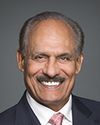There are a couple of things here.
First of all, on the rules of origin, our association, working with the European association, had an exchange of letters with the chief negotiator during the CETA to suggest that we needed an easy way to know when origin was achieved. What we proposed was something that could be understood by the people doing the transaction rather than by the government. As much as possible, we tried to take constructed value out of the equation. That was what the European administration wanted but not what the companies in Europe wanted.
We put together some proposals for rules of origin that would result in.... If it were a chemical reaction, we changed the essential character. It's something different. Origin is achieved. We put forward some very simple rules.
We're in the process now of doing something similar with our counterparts in Mexico and the United States. While we have a statement supporting free trade among the three countries, now what we're getting into is looking at the rules of origin and what they should look like in the dozen chapters that constitute chemicals out of the hundred chapters of the harmonized system of global trade.
It's important that the companies undertaking transactions and trading have some idea of how they're going to be treated, whether the goods qualify or not, and so the rules need to be transparent enough and simple enough that they don't allow someone in commerce to construct a value and say, “No, no, you don't qualify anymore.” This has to be transparent.
Our American counterpart association recognizes that if they have $250 billion in new capacity coming online, 80% of which needs world markets, they need to be looking outward and not inward. This isn't protectionism. This is about opening up trade. Their rules of origin will be our.... We'll have a common proposal.
There is one other aspect to this, which is the origin labelling. With fungible goods, we haven't figured out a way to stamp “made in Canada” on each molecule yet, so a paper trail is still required. But I have to tell you, the rules in NAFTA are sufficiently opaque that some of our members choose to pay the World Trade Organization duty, the MFN rate, rather than going through the paper trail of proving origin in Canada. Improving the NAFTA to have better transparency is something we want on both sides of the border.




